Hydrophilic silicone oil is generally colorless (or light yellow), odorless, non-toxic, non-volatile, excellent heat resistance, electrical insulation, weather resistance, hydrophobicity, physiological inertia and low surface tension. In addition, it has a low temperature coefficient of viscosity, high compression resistance, and some varieties are also radiation resistant.
1. Add a very small amount of low-viscosity silicone oil, polyether-modified hydrophilic silicone oil and fatty acid ester-modified hydrophilic silicone oil to the paint to prevent uneven color and wrinkles and increase the durability of paints and varnishes. vividness. High-viscosity hydrophilic silicone oil can be used as a defoamer for coatings, etc.
2. Hydrophilic silicone oil is very effective as an anti-adhesive agent for plywood coating. Plywood coatings are usually made from amino alkyd resins. Coatings have low hardness and tend to adhere to each other when stacked. When the film is pulled apart, the film can be damaged. Adding about 0.5% hydrophilic silicone oil can avoid plywood sticking.
3. Use hydrophilic silicone oil to prepare ceramic polished tiles, and use hydrophilic silicone oil as an antifouling agent in coatings. The antifouling agent has good penetration and adhesion to the micropores and surface of the polished tile body; at the same time, the coating has high transparency, and after the surface of the polished tile is covered, the color and luster of the tile will not be adversely affected; And various organic solvents are very stable.
The use of compounds of the formula R3SiX2 (R=aryl; X=anion) and hydrophilic silicone oils as antifouling agents for fishing gear and related equipment can prolong the antifouling performance and prevent the growth of marine organisms.
4. A room temperature curing type silicone coating having hydroxyl hydrophilic silicone oil as a main component and used for ship structures. Polyorganosiloxane emulsion coatings for airbag films containing hydrogen-hydrophilic silicone oil as the main component have good adhesion to fabric substrates and high mechanical strength.
5. Use hydrophilic silicone oil to form a weather-resistant silicone resin coating on the surface of resin plates and plastic parts of automobile headlights to prevent dust interference.
Hydrophobic siloxane type vapor deposition coating for optical instruments, which is made of hydrogen-containing hydrophilic silicone oil, which has a water contact angle greater than 80 degrees, and is especially suitable for protecting lenses of cameras and binoculars.
It contains an alkoxysilane coating, the coating can be quickly cured, and the film thickness can be well controlled in the micron range; the formed glassy film is flexible enough to adhere to the substrate, and light and abrasion resistant, scratch-resistant, impact-resistant and resistant to organic solvents.
 English
English 日本語
日本語 한국어
한국어 français
français Deutsch
Deutsch Español
Español italiano
italiano русский
русский português
português العربية
العربية tiếng việt
tiếng việt
